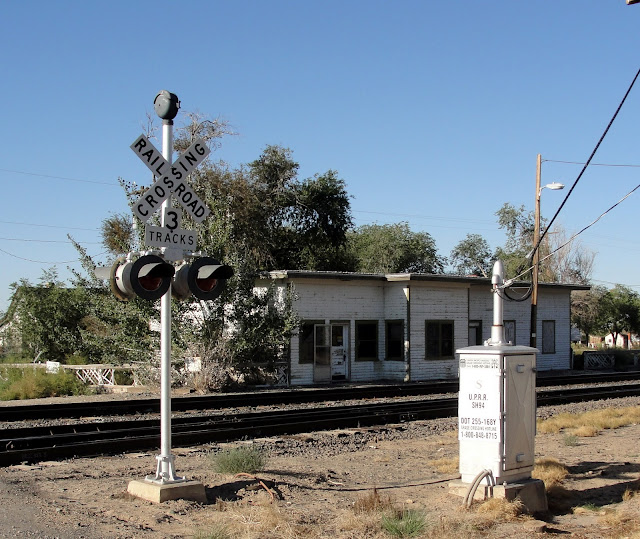October 8, 2011
Autumn Trails
Happy autumn trails to all of you. We'll be away from blogging, following our own paths to adventure for the next month. We'll catch up with you in mid-November.
October 5, 2011
Autumn in the Mountains
The Utah hills are in their golden glory.
A lane on the top of Lake Mountain (9000 ft.) displays the aspen in their prime time finery.
Near the top of Indian Canyon, nearly all of the aspens are dressed for fall.
A cold front is due this week. If we get wind as well as cooler weather (and possible snow!), the gold will be gone for another year.
October 2, 2011
Thompson Springs
Less than a mile north of I-70 at the turnoff to the Sego ghost town and the Thompson Wash petroglyphs, lies the town of Thompson Springs. The 2010 census shows less than 39 residents.
A lot of the houses look like the one above, dilapidated and possibly deserted.
This white building gives us a taste of the town's history.
The sign in front tells the story.
The town was once important enough to merit a train stop at this station.
Parking is still available, but the old sign is overgrown with weeds.
This old building still has a sign for the Desert Moon Hotel. Someone seems to be living there and maintaining the place, but I saw no evidence that the hotel is currently in business. A gas station near the interstate is the only viable business we saw.
The town was established in 1890 and its importance was boosted by the coal mine in Sego, now defunct. Sadly, although it isn't quite a ghost town, Thompson doesn't seem to have much life left.
A lot of the houses look like the one above, dilapidated and possibly deserted.
This white building gives us a taste of the town's history.
The sign in front tells the story.
The town was once important enough to merit a train stop at this station.
Parking is still available, but the old sign is overgrown with weeds.
This old building still has a sign for the Desert Moon Hotel. Someone seems to be living there and maintaining the place, but I saw no evidence that the hotel is currently in business. A gas station near the interstate is the only viable business we saw.
The town was established in 1890 and its importance was boosted by the coal mine in Sego, now defunct. Sadly, although it isn't quite a ghost town, Thompson doesn't seem to have much life left.
October 1, 2011
Thompson Wash
A few miles south of the Sego ghost town, we found another variety of ghosts left by ancient Native Americans in their rock art. The site is known as Thompson Wash.
The above figures are in the Barrier style, dating from about 4000 years ago. The pictographs (painted on the rock with red dye) show anthropomorphic figures that are often larger than a man. They often have a ghostly look, and are shown with snake-like figures.
In the same area are other figures in the Fremont style, dating from about 1500 years ago:
Fremont anthropomorphic figures are triangular, often shown with shields and necklaces.
The historic Utes also left their art, which is about 800 years old:
Note that some of the human figure appear on horseback, which means the art dates from after Spanish conquistadors brought horses onto the continent in the late 1400's.
The above figures are in the Barrier style, dating from about 4000 years ago. The pictographs (painted on the rock with red dye) show anthropomorphic figures that are often larger than a man. They often have a ghostly look, and are shown with snake-like figures.
In the same area are other figures in the Fremont style, dating from about 1500 years ago:
Fremont anthropomorphic figures are triangular, often shown with shields and necklaces.
The historic Utes also left their art, which is about 800 years old:
Note that some of the human figure appear on horseback, which means the art dates from after Spanish conquistadors brought horses onto the continent in the late 1400's.
This panel shows a mixture of styles, with some historic Ute or Fremont figures, and some cowboy/miner/tourist art dating from the 1880's.
It's illegal, not to mention a real shame, to deface the rare remnants of ancient cultures, but some people just can't seem to resist making their mark.
Subscribe to:
Posts (Atom)

















